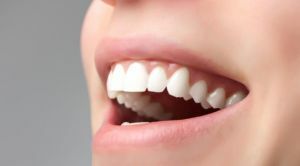 Dental crowns are non-removable dentures that protect and strengthen the damaged teeth, restoring their original shape.
Dental crowns are non-removable dentures that protect and strengthen the damaged teeth, restoring their original shape.
The most common types: metal, metal-ceramic and all-ceramic. Each other is different material.
Contents
- Ceramics as a material for dental prosthetics
- Use of ceramics in dentistry
- About pros and cons seriously
- Indications for installation
- Before procedure. ..
- Installation step by step
- Crown care
- How are
- manufactured? Service life
- Asked - answer
- Costbites
- In dry residue
Ceramics as a material for prosthetics of teeth
Properties of ceramic material:
- Biological inertness, the human body does not reacton ceramics as an alien body.
- No harmful substances.
- Ceramics does not absorb foreign odors.
- Does not react with pigments and bacteria.
- Does not cause inflammation of the gums.
- Has high strength.
- Ceramic crowns are very similar to natural teeth. They accurately imitate color, transparency, the structure of natural dental tissue.
- No metal frame in the crowns. This makes them thinner than their metal-ceramic counterparts, which has a consequence in the form of a minimal turning of the tooth.
Use of ceramics in dentistry
Ceramic crowns are dentures in the form of a ceramic hood that restores the original appearance of the crown part
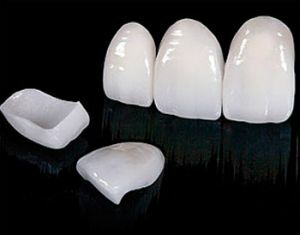
Veneers made from ceramics
of a destroyed tooth. The most expensive kind of dental crowns. Ideal option for prosthetics of the front teeth.
In dental practice, ceramics are used in the manufacture of single crowns, dental bridges, removable structures, veneers, special inserts and linings that repair some of the damaged tooth.
Ceramic prostheses are made of zirconium oxide and pressed ceramic mass. There are all-ceramic( porcelain), all-zirconium crowns, prostheses with a frame of zirconium, lined with ceramic mass.
About pros and cons seriously
Advantages over other types of crowns:
- Longevity - serve for at least 10 years with the observance of medical advice. Do not crack, do not crumble, do not stain with dyes, do not deform. Damages and chips are well restored.
- Lightness - does not overload the supporting teeth when chewing.
- Safety - does not have harmful effects on the body, does not provoke abrasion of the opposite teeth, under the prosthesis there is almost no inflammatory process. Do not oxidize, do not spoil the taste of food.
- Absence of allergic reactions - unlike metals hypoallergic and does not give food a taste of metal in the mouth.
- Minimal injury to the supporting teeth - ceramic crowns are made very thin and strong, so they are fixed on the supporting teeth with a minimum turning of the latter.
- Aesthetics - this kind of dentures is difficult to distinguish from natural teeth due to the luminous brilliance of the enamel and the ability to transmit light.
- Easy handling and no irritation to the in the oral cavity.
The disadvantages are:
- A significant drawback of ceramic crowns can be considered their brittleness .In this they lose metal.
- A small selection of materials. Only zirconium and porcelain are used. Of these, only zirconium is suitable for prosthetics of chewing teeth.
- The disadvantage of the is the high cost of the ceramic construction.
Indications for installation
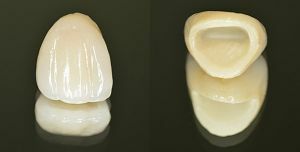 In case of allergy to metals, teeth prosthetics in the smile zone, when a titanium implant is required to replace the crown, in order to avoid contact of different metals - it is recommended to install a ceramic crown.
In case of allergy to metals, teeth prosthetics in the smile zone, when a titanium implant is required to replace the crown, in order to avoid contact of different metals - it is recommended to install a ceramic crown.
Contraindications to prosthetics with ceramic structures:
- state of pregnancy;
- various inflammations in the mouth;
- chronic illness;
- weakened state of the body;
- marked osteoporosis.
Before the procedure. ..
To set the crown, the tooth must be prepared. This includes visual examination of the tooth by an orthodontist, direction to the X-ray, procedures for the treatment and filling of the canal, removal of the nerve if necessary.
Then follows the turning of the tooth, or the removal of a certain layer of dental tissue. The thickness of the removal is in the range of 1.5 - 2 mm and depends on the size of the walls of the prosthesis.
If the tip of the tooth is missing completely, a metal dental tab is used to fix the crown. The practice of establishing the pins is now obsolete.
Installation step by step
Ceramic dental crowns are installed on the teeth in the same order as the others with slight differences. This concerns a lower degree of turning compared to crowns made from other materials and the ability not to remove the nerve if the dental canals are healthy.
Otherwise, the procedure for installing the crown consists of making casts, making a model of gypsum, selecting a color shade of ceramics( there is a special scale), creating a crown in the laboratory, fitting the prosthesis and fixing it for temporary cement, fixing the finished prosthesis to the previously prepared tooth.
"Adhere" orthopedic structures with special cement. He holds the prosthesis on the supporting tooth for a long time and reliably.
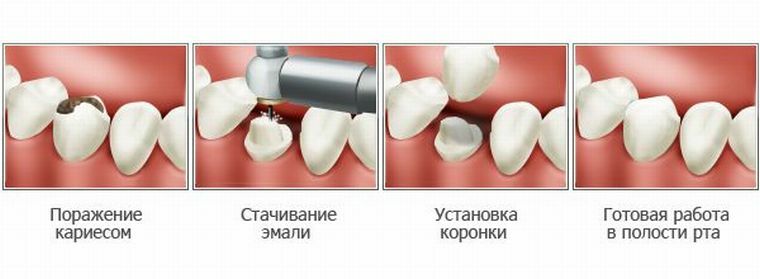
Crown Care
To prolong the life of ceramic prostheses, it is necessary to perform simple hygienic procedures for the oral cavity: clean your teeth every day, do not bite hard foods, so as not to damage the crown and injure the supporting tooth under the crown, do not use toothpaste with high abrasiveness.
A prophylactic examination of the teeth by a doctor is necessary twice a year.
How are
made Metal-free ceramic crowns for dentures are made in two ways: manual and computer. The choice of the method depends on the technical equipment of the clinic and the laboratory and the type of material used:
- The hand method consists of the following steps: taking the impression of both patient's jaws, making a demountable gypsum model, modeling the future crown, pressing the crown frame, carcass coating, glazing and polishing the resulting crown. In the final stage, the crown is treated by one of two methods: for chewing teeth - surface staining, for the front teeth - layering.
- Computer method creates high-precision designs, with virtually no errors. This requires the presence of modern dental equipment, which simulates the crown virtually. Schematically it looks like this: using a computer scanner to create a computerized snapshot, a special program simulates the future view of the crown and sends information about it to the milling equipment, which fetches the specified parameters from the blanks. The resulting crown can be modified by the dental technician manually if necessary.
Service life
Ceramic crown can last from 5 to 10 years, depending on the attitude of the patient to it. After the expiration of this period, it is recommended to replace it, in order to avoid the destruction of the tooth under the crown.
Asked - answer
Patients of dental clinics are often interested in questions:
- Is it possible to put metal-free ceramics on chewing teeth? Answer: You can. In this case, crowns from
 zirconium dioxide are suitable. This is a biocompatible and hypoallergenic material, giving crowns strength 1.5 times higher than conventional ceramics. The absence of a frame made of metal gives the zirconium crown the most natural appearance. The walls of these crowns are thin. This makes them easier. Unlike any metal, zirconium dioxide retains 10 times less pathogenic microorganisms.
zirconium dioxide are suitable. This is a biocompatible and hypoallergenic material, giving crowns strength 1.5 times higher than conventional ceramics. The absence of a frame made of metal gives the zirconium crown the most natural appearance. The walls of these crowns are thin. This makes them easier. Unlike any metal, zirconium dioxide retains 10 times less pathogenic microorganisms. - The crown of zirconium has darkened. Why? Answer: Metal-free zirconium crowns should not darken. If this still happened, you should check the compliance with the technology of its production and installation, as well as a possible reason for non-compliance with the regularity of oral hygiene procedures.
- The cleave formed on the crown. Can I remove it without removing the crown? Answer: The chips on the ceramic crowns can be removed without removing the prosthesis with the help of composite materials. A dentist in a polyclinic will eliminate this defect. In case of severe damage, it is recommended to replace it.
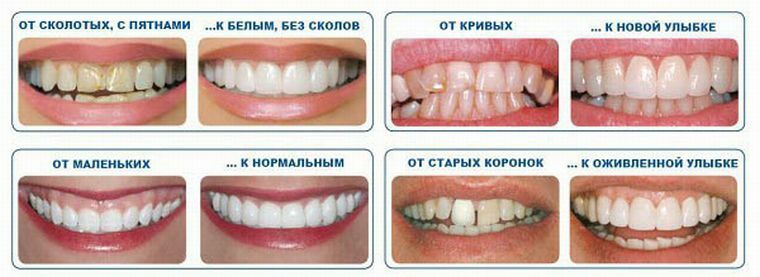
The photo clearly shows how the teeth look after they were fitted with a ceramic crown
Cost bites
Prices for ceramic crowns are quite high. Each medical institution has its own price and fluctuations in price are very significant.
In the Russian capital, metal-free ceramics can be supplied from 8,990 rubles.up to 46900 per crown. Ceramic crown will cost from 12,000 rubles.up to 58900 rubles. But these are very approximate figures.
Specifically, you can find out the cost of a dental crown only at the on-site consultation of a dentist.
In the dry residue of
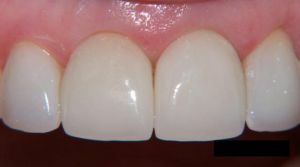 Any patient of a dental clinic who came there with a view to prosthetics faces a choice of what to prefer. Undoubtedly, the first adviser for him will be the attending physician. A good dentist always acts in the interests of the patient and enlightens about the positive and negative aspects of different methods of prosthetics, advises the best option.
Any patient of a dental clinic who came there with a view to prosthetics faces a choice of what to prefer. Undoubtedly, the first adviser for him will be the attending physician. A good dentist always acts in the interests of the patient and enlightens about the positive and negative aspects of different methods of prosthetics, advises the best option.
Which material is preferred for crowns, the patient decides jointly with the physician individually in each specific case.
To date, the popularity of cast ceramic all-ceramic crowns, and made by the method of ceramic spraying on a frame of the same material. For teeth prosthetics, smile zones are clearly the best option. It should also be remembered that good quality work can not be cheap and quickly done.
Reviews of patients who have established ceramic structures are only positive.
